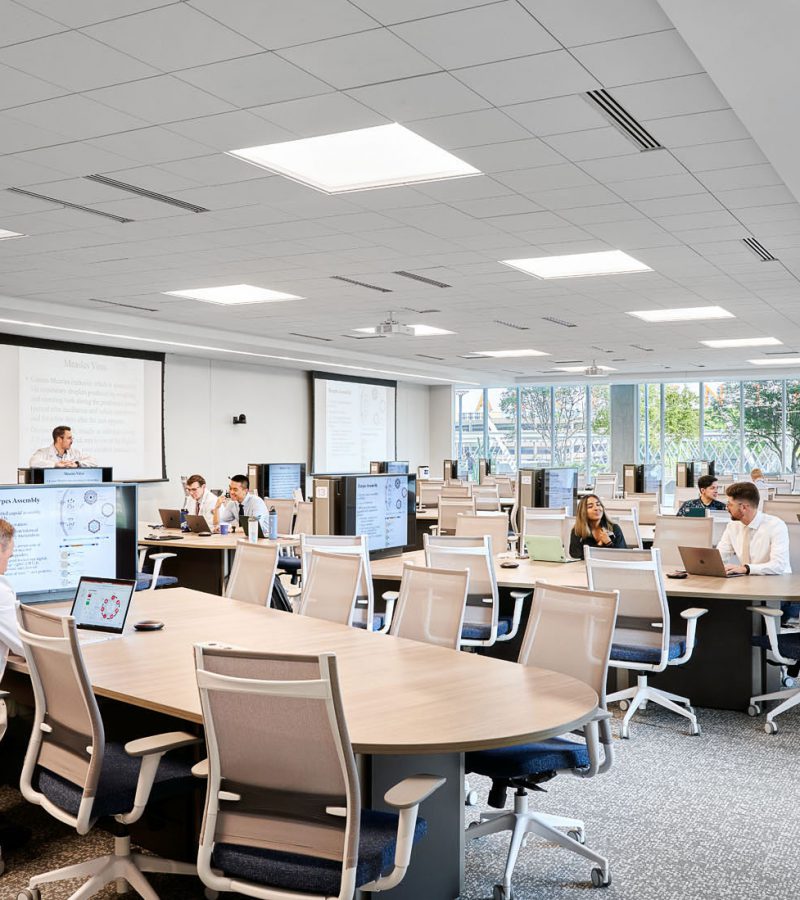5 Audiovisual Learning Spaces
1. Active Learning Classrooms
For many years, classrooms consisted of an instructor at the front and students in rows of seats. This is also known as “didactic” teaching. Audiovisual systems can be an asset in these more traditional classrooms, providing image projection and voice amplification, as well as assistive listening systems and lecture recordings. However, audiovisual systems became a true asset with the rise of Project Based Learning implemented in active classrooms.
Project Based Learning sees students break up into groups and work on one project over a longer time period. Active learning classrooms have “pods” of 5-9 students each with a device, such as a laptop or tablet, which they use to work on their assigned project. These rooms have technology built in that allows each pod to display content from any or all of the students as they work through problems together.
“Should instructors wish to share solutions or address challenges,” explains Steve Miller, CTS, an audiovisual designer at IP Design Group, “they can share content among pods or use larger screens on an ‘attention wall.’” Cameras can provide remote learners with the opportunity to engage live and absent learners to watch a recording so they don’t miss the day’s lesson. “This active learning technology is efficient and scale-able thanks to the latest generation of video and audio over ethernet,” Miller continues.



2. Corporate Training Environments
Learning is a lifelong commitment, something corporations actively support through training programs. Corporate training spaces can take many lessons from higher education classrooms, providing intuitive tools for instructors and increase concept retention for learners. The technological adaptations made to education spaces as a result of the COVID-19 pandemic can also be translated to the corporate environment, enabling training to occur in branch offices and even the homes of remote workers.
3. Conference Centers
Large-scale learning spaces benefit from audiovisual systems, too, beyond simply projecting a presentation. Right when attendees walk into the room, screens throughout the space can be used to display information from corporate branding to initial instructions. Zoom and Microsoft Teams give remote attendees the tools they need to feel like they are in the room. Advances in audiovisual signal transport have revolutionized the design and distribution models for these types of spaces, allowing supporting equipment to be located in one secure location out of the way of attendees.
4. Medical Simulation Spaces
Universities that offer medical training have unique technological requirements. Medical simulation centers record everything that happens throughout the instruction process from inserting IV lines into simulation mannequins to scrubbing for surgeries and interacting with mock patients. These recordings become part of the student’s record and are used for further instruction, as well as assessment. Medical simulation spaces must be carefully planned to accommodate dozens of cameras, microphones, digital encoders and decoders, displays, and racks of storage servers.
5. Content Creation Studios
At first glance, a content creation studio may not seem like a learning environment, but its main strength is creating content that can educate people remotely through livestreams and videos. In its simplest form, a content creation studio is an enclosed space that has had acoustical treatments to keep quality sound in without letting it escape to distract surrounding areas. It also features specialty lighting to allow for the best possible color, contrast, and definition of the subject being recorded.
These studios can range in size from a 10’x12’ room to a full production facility of over 40’x50’. A smaller room might be used by a university or business to create how-to videos or executive announcements. Large-scale content creation studios may have multiple cameras, set pieces, a control room, green room, and an editing suite to produce in-house product commercials, demonstrations, or interviews.
“Thanks to high-definition pan-tilt-zoom (PTZ) cameras, green-screen cyc-walls, and digital effects generators, even large studios can produce content with limited production staff and post-production editing,” Miller reveals. “For a corporate studio with a production control room, we can employ digital signal transport throughout the facility to remote endpoints. This means an event, say an all-hands meeting in the food hall, can leverage the control room for increased production value before being broadcast to the rest of the facility and recorded for future viewing.”


Steve Miller, CTS, finds the ever-changing landscape of audiovisual technology to be exciting because it pushes him to continually learn. Learning is one of his passions, which is one of the reasons designing audiovisual technology for educational spaces is so rewarding for him. With over 20 years of experience, Steve has designed systems for remote-learning, large-venue lecture halls, medical simulation spaces, content creation studios, and technology enhanced conference centers.
Is your next project a learning space? Interested in some of the audiovisual systems you read about above? Contact us today to get started!



